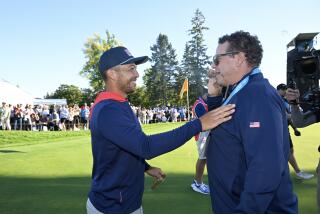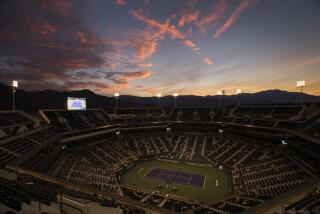Chang, Davis Cup Hopes Have Resurfaced on Clay
- Share via
Red clay, green clay, Har-Tru, Fast-Dry, indoor carpet, outdoor grass, cement, asphalt, Michael Chang’s backyard--never mind the surface, the real story behind this year’s Davis Cup final is what has finally resurfaced.
Yankees, welcome home.
Three years ago, you had to wonder if they were gone for good. Paraguay had left the Americans paralyzed--the renowned Hugo Chapacu and Victor Pecci led a first-round insurrection against the United States--and a relegation-match loss to West Germany dragged the carcass off to the river. Relegation matches are to Davis Cup what loser-leave-town bouts are to wrestling. The United States left town, all right, banished to a tennis purgatory known as the Zonal Group, perhaps never to return.
The Zonal Group is the third world of the Davis Cup. The Zimbabwes and the Togos and the Sri Lankas hang out there, forming a Davis Cup minor league that plays each year to send four teams into the next year’s main draw.
This was American men’s tennis at its nadir. Any lower and you could have slipped Tom Gorman’s squad under the net.
In 1988, Gorman’s pass through Zonal competition meant winning twice on the road--at Peru and at Argentina--in order to return the United States to the land of the living in 1989. Remedial work done, the U.S. team went three rounds into the ’89 main draw but only three, failing to reach a Davis Cup final for the fifth consecutive year.
Today, however, they are back. Back in the final, back in the role of the favorite, back on American soil--although, if the United States Tennis Assn. had had its way, that soil would have been imported from Europe.
“An unbelievably dramatic turnabout,” says ESPN tennis commentator Cliff Drysdale, in St. Petersburg, Fla., for this weekend’s final against Australia. “I never would have imagined they’d turn it around so quickly . . .
“And if they beat the Australians here, and I don’t foresee any problem at all, that will put a cap on that story. More interesting to me than the controversy about playing on a clay court is the fact that the U.S. is back and will remain a Davis Cup contender at least through the next decade. Look at the young players they have--(Pete) Sampras on hard court, (Andre) Agassi and (Placentia’s) Chang on clay. Their depth of talent is so much deeper than anyone else in the world right now.
“The U.S., I think, is in for the long haul in the Davis Cup.”
It has been a youth explosion--in two years, a complete Davis Cup roster turnover.
At 17, Chang wins the French Open.
At 19, Sampras wins the U.S. Open.
At 20, Agassi wins the Masters of men’s tennis, the ATP Championships.
And at 25 and 26, Rick Leach and Jim Pugh have replaced Ken Flach and Robert Seguso as the world’s pre-eminent doubles pair.
Stranger still, these young Americans function best on clay, that insidious foreign substance that beat them in Paraguay, beat them so many times in Davis Cups past, and kept them winless in Paris for 30-odd years until Chang’s 1989 breakthrough.
Six years ago, U.S. fear and loathing of clay ran so deep that Sweden, in preparation for the 1984 Davis Cup final, rolled in truckloads of the stuff in order to build an indoor clay court--digging the eventual grave for the American dream team of John McEnroe and Jimmy Connors.
Now, the Americans are the ones ringing up 1-800-REDCLAY. They even tried to go overseas for it--German clay is the best because it’s the slowest--but they had the plan rejected after the Australians protested, citing a Davis Cup rule that prohibits playing on any surface not common to the host country.
So, the USTA bought its clay from Alabama instead.
This has fueled a debate that will no doubt rage past this weekend, but Drysdale, for one, chides the Australians for “making a mountain out of a molehill. They claim that clay is ‘not a surface in general use in this country,’ but it is used for more Davis Cup matches around the world than any other surface.
“It just so happens now that the U.S.’ best players are clay-court players. Two years ago, no one could have imagined it.”
The Americans are playing with clay because of Agassi and Chang. Both thrive on the surface, Chang especially, and the USTA figures it owes Chang one, anyway.
Without him in Vienna, the United States wouldn’t be in St. Pete today.
It was on Austrian clay in September where the Americans lay, mired, following Agassi’s singles loss to Thomas Muster. That tied the tie at 2-2, and when Chang lost his first two sets to Horst Skoff, the Horst with some game, the United States seemed ready to cash in. Good night, Vienna.
But Chang refused to leave. Relentlessly pounding away from the baseline, he won the third set, 6-4. Relentlessly pounding away from the baseline, he won the fourth set, 6-4. At once battling 18,001 Austrians--one holding a racket, 18,000 others raising one--Chang fought through the fifth set, too, exacting a 6-3 victory that was nothing short of heroic.
“One of the all-time great ones,” Drysdale says of Chang’s performance. “He was two sets down and you never really felt he was out of it.
“He’s a very gutty player. He had everybody in the stadium pulling against him, they were cheering first-serve faults, there was a lot of tension in the air. I don’t think there’s any other sport that puts an athlete through what Chang went through.
“He absolutely had to win that match and he did. Probably--no, not probably--he is the strongest player, mentally, there is on the tour. Put him in a tight situation and I’ll put my money on him.”
Put him on clay and he should be able to put the Australians away. That’s why the USTA has put its money into good, solid, firm, s-l-o-w Alabama soil.
More to Read
Go beyond the scoreboard
Get the latest on L.A.'s teams in the daily Sports Report newsletter.
You may occasionally receive promotional content from the Los Angeles Times.










